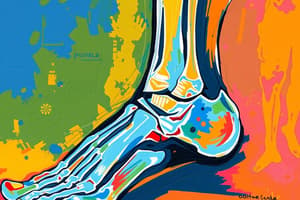Podcast
Questions and Answers
What is Charcot Arthropathy?
What is Charcot Arthropathy?
Charcot Arthropathy is a progressive non-infectious destructive arthropathy caused by loss of protective mechanisms in patients with a sensory neuropathy commonly associated with diabetes.
Charcot Arthropathy can only occur in the presence of a neuropathy.
Charcot Arthropathy can only occur in the presence of a neuropathy.
True (A)
Which of the following conditions can lead to Charcot Arthropathy? (Select all that apply)
Which of the following conditions can lead to Charcot Arthropathy? (Select all that apply)
- Leprosy (correct)
- Hypertension
- Alcoholism (correct)
- Diabetes (correct)
What is the incidence of Charcot Arthropathy in diabetics?
What is the incidence of Charcot Arthropathy in diabetics?
What are the main areas of the foot affected by Charcot Arthropathy?
What are the main areas of the foot affected by Charcot Arthropathy?
Charcot Arthropathy is most commonly seen in patients with _____ in the developed world.
Charcot Arthropathy is most commonly seen in patients with _____ in the developed world.
How long does it typically take for Charcot Arthropathy to affect the second foot in bilateral cases?
How long does it typically take for Charcot Arthropathy to affect the second foot in bilateral cases?
What are the two main theories explaining the cause of Charcot Arthropathy?
What are the two main theories explaining the cause of Charcot Arthropathy?
The neurotraumatic theory postulates that Charcot Arthropathy is an exaggerated _____ injury.
The neurotraumatic theory postulates that Charcot Arthropathy is an exaggerated _____ injury.
What are the classic findings in Charcot Arthropathy?
What are the classic findings in Charcot Arthropathy?
In the examination of Charcot Arthropathy, patients typically report significant pain.
In the examination of Charcot Arthropathy, patients typically report significant pain.
What should be assessed before any surgical intervention in Charcot Arthropathy?
What should be assessed before any surgical intervention in Charcot Arthropathy?
Flashcards are hidden until you start studying
Study Notes
Charcot Arthropathy - Overview
- Progressive non-infectious destructive arthropathy linked to sensory neuropathy, often seen in diabetes.
- Also known as neuropathic arthropathy; occurs solely with the presence of neuropathy.
- Characterized by fractures, collapse, and destruction, leading to a rocker bottom foot.
- Complications include ulceration, infection, and osteomyelitis.
- Distinction between Charcot arthropathy (non-infective) and infection is crucial; assess vascular status before surgical intervention.
Charcot Arthropathy - Epidemiology
- Predominantly affects diabetics in Australia and developed regions; also common in leprosy globally.
- Syringomyelia is the leading cause in the upper limb.
- Incidence among diabetics is 7.5%; prevalence increases in those with peripheral neuropathy (30%).
- Average time to bilateral involvement is two years; simultaneous presentation is rare.
- Midfoot is most commonly affected (60%), followed by hindfoot (30%).
Charcot Arthropathy - Anatomy
- Usually impacts midfoot joints, divided into three groups:
- Distal tarsometatarsal joints (Lisfranc joints)
- Middle intermetatarsal joints
- Proximal transverse tarsal joints (Chopart joints)
- Can also affect the ankle, hindfoot, and occasionally the forefoot.
Charcot Arthropathy - Aetiology
- Results from any condition causing sensory neuropathy, leading to overuse of foot and ankle.
- Commonly associated with advanced diabetes complications: neuropathy, retinopathy, and nephropathy.
- Typically occurs in individuals aged 50-60 years or older; type II diabetes shows quicker onset than type I.
Charcot Arthropathy - Pathophysiology
- The exact cause of Charcot arthropathy remains unknown but can occur in any joint.
- Minor trauma can lead to significant joint destruction in the presence of neuropathy.
- Most often affects the foot and ankle, but may occur in elbows, shoulders, knees, and hips.
- Leads to the typical rocker bottom foot deformity; theories include neurotraumatic and neurovascular explanations.
Charcot Arthropathy - Neurotraumatic Theory
- Suggests Charcot arthropathy stems from exaggerated repetitive overuse injuries in insensate joints.
- Single traumatic events or repeated microtrauma contribute to destructive changes and joint collapse.
- Normal protective behaviors, such as weight-bearing restrictions, are absent due to abnormal sensation.
- Animal studies show sensory denervation leads to a high incidence of Charcot arthropathy.
Charcot Arthropathy - Neurovascular Theory
- Proposes autonomic dysfunction increases blood flow, leading to bone resorption and weakening.
- Weakened osteopenic bones, combined with insensitivity, result in fractures and joint collapse.
Charcot Arthropathy - Causes
- Associated with various conditions, including spinal issues, alcoholism, diabetes neuropathy, tabes dorsalis, leprosy, and insensitivity to pain.
- Differential diagnosis should include chronic osteomyelitis of the foot and ankle.
Charcot Arthropathy - Surgical Consideration
- Surgical intervention considered only when amputation is the sole alternative.
Charcot Arthropathy - Clinical Findings
- Clinical examination reveals an inflamed foot and ankle, deformity, decreased range of motion, and potential skin ulceration.
- Patients typically remain pain-free despite significant joint destruction.
Studying That Suits You
Use AI to generate personalized quizzes and flashcards to suit your learning preferences.




